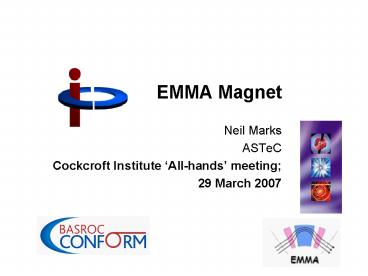EMMA Magnet PowerPoint PPT Presentation
Title: EMMA Magnet
1
EMMA Magnet
- Neil Marks
- ASTeC
- Cockcroft Institute All-hands meeting
- 29 March 2007
2
Acknowledgements
- With considerable thanks to
- Ben Shepherd
- Take Yokoi (Adams Institute)
- Neil Bliss
- Clive Hill,
- (who have done most of the work and produced most
of the material that you are about to see).
3
The EMMA Ring
4
Early plan view of magnets in EMMA lattice
5
EMMA Magnets Unusual Features
- magnets provide both dipole (bending) and
quadrupole (focusing) field they are combined
function magnets - the quadrupole field is far stronger than the
dipole field they are therefore displaced
quadrupoles - independent adjustment of the dipole and
quadrupole field is required - they are very short yoke lengths of 55mm and
65mm of the same order as the inscribed radius
all ends and no middle.
6
EMMA F type Magnet
7
EMMA D type Magnet
8
Current Magnet Parameters.
9
EMMA Cells in 3D
10
Modelling carried out with CST EM Studio (3D code)
F magnet
D magnet
now with realistic steel details provided by
Tesla
Combined model
http//www.cst.com/
11
Difference between separate and combined models.
12
Field Clamps
- Tracking studies suggest that field clamps are
needed - Reduce the amount of field leaking into the long
straight - Symmetric or asymmetric?
- Occupy space and increase power demand
13
Field Clamps
- Integral gradient reduced by 11 (F) 18 (D)
- Little effect on good gradient region
- No saturation in the clamp plate
14
Field Clamps
Field at clamp reduced by 80 in each case
F magnet
D magnet
Difference between asymmetric and symmetric
windows is negligible
15
Optimisation of gradient quality -tangent point
variation
QBD tangent point 10mm
tangent point 48mm
16
Investigation of field quality in 2D in QF,
tangent at 45 mm (OPERA 2D).
17
Results as Dg(x)/g(0) for QF, tangent at 45mm.
18
Optimisation of integrated gradient quality-
variation of chamfer on pole ends
Angle can be adjusted to 45 used up to now
19
Modelling in 3D using OPERA
20
Variation of ?g(x).ds in QF between different
limits tangent at 11 mm, no chamfer.
21
Further Work
- proceed with tender exercise for 2 prototypes
- continue with 3D work using both OPERA 3D and CST
EM Studio - proceed with detailed 3 D measurements of
prototypes on delivery.
PowerShow.com is a leading presentation sharing website. It has millions of presentations already uploaded and available with 1,000s more being uploaded by its users every day. Whatever your area of interest, here you’ll be able to find and view presentations you’ll love and possibly download. And, best of all, it is completely free and easy to use.
You might even have a presentation you’d like to share with others. If so, just upload it to PowerShow.com. We’ll convert it to an HTML5 slideshow that includes all the media types you’ve already added: audio, video, music, pictures, animations and transition effects. Then you can share it with your target audience as well as PowerShow.com’s millions of monthly visitors. And, again, it’s all free.
About the Developers
PowerShow.com is brought to you by CrystalGraphics, the award-winning developer and market-leading publisher of rich-media enhancement products for presentations. Our product offerings include millions of PowerPoint templates, diagrams, animated 3D characters and more.

